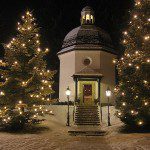This is the second reflection in our Advent Series, "The Hopes and Fears of All the Years," by biblical scholars and preachers John C. Holbertand Alyce McKenzie.For an overview of the series with links to all the reflections, click here.
Second Sunday in Advent.
Matthew 3:1-12
Last week we considered the pervasive snow globes of the season, and the ways that often they seem so removed from real life. Our text for today could yield one poignant snow globe scene and several grim ones.
The poignant one would be a man in rough garments baptizing people in a river. "The people of Jerusalem and all Judea went out to him and all the region along the Jordan. They were baptized by him in the river Jordan, confessing their sins" (Mt. 3:6). I wonder why these people went out to him and were baptized by him in the river Jordan, confessing their sins? I wonder why they underwent this water baptism symbolizing their repentance for past sins?
I hope nobody ever encases this poignant scene in a glass dome with little snowflakes circulating around it. It's too serious, too mysterious for that. John seems to view the people from Jerusalem and all Judea in a positive light, as if they were motivated by a genuine desire to repent and turn toward God to know God better.
By contrast, Matthew 3:7-12 would yield several grim, ominous snow globe scenes.
Snow globe scene one: A man with an angry face wearing clothing of camel's hair with a leather belt around his waist, locusts and honey dripping from his mouth.
Snow globe scene two: A tree with an ax at its root.
Snow globe scene three: Jesus with a winnowing fork in his hand clearing the threshing floor.
Snow globe scene four: Jesus burning the chaff. (I don't think this last one would work, because the liquid in the snow globe would put out the "unquenchable fire" [Mt. 3:12].)
Somehow, I don't think that grim scenes of punishment fit the snow globe genre. But they seem to fit the genre of John's preaching to the Pharisees and Sadducees. I have often wondered why he lit into them like he did. They are coming to the River. It looks like, from the outside, they are doing what God wants them to do.
I wonder if the dynamic is that he doesn't want them to turn and be saved. I wonder if this is a Jonah and the Ninevites' dynamic. I'll preach good news, God, just not to them. I'll preach repentance, God, but I'm hoping they won't listen.
How does John know what they're thinking? "Do not presume to say to yourselves . . ." He has an insight into their hearts and the fact that they are complying outwardly but inwardly their hearts are not repentant. He believes that their sense of entitlement has soured the core of their religion. He contrasts what they do (flee from the wrath to come, 3:7) with what they should do (bear fruit that befits repentance, 3:8). They are motivated by a fear of punishment rather than by a desire to turn toward God and love their neighbor. (See Daniel Patte, The Gospel According to Matthew, [Trinity Press International, 1996], 46.) Those who are not willing to bear fruit that befits repentance are not eligible for the baptism of repentance. Repentance is not the attitude of evildoers but of good doers.
For Matthew, repentance is turning toward God to allow all one's motives and actions to flow from obedience to God as one's supreme authority. Confession of sins is pointless (it is fleeing from the wrath to come) if it is not part of the process of submitting one's entire life to God's authority. (See Patte, 49.)
Daniel Patte calls this passage "From John's Ministry to Jesus' Ministry." In comparing John's ministry in 3:1-12 with Jesus' ministry described in 4:12-25, he notes that John's ministry includes promises and potentialities that are fulfilled in Jesus' ministry. John rebukes and rejects people (Pharisees and Sadducees, 3:7-10). Jesus calls people to follow him (disciples, 4:18-22). John stays in one place, and people from Judea come to him (3:5). Jesus goes to various locations (from Nazareth to Capernaum, to the Sea of Galilee, 4:13, 18). He is constantly on the move and is followed by people from Galilee and the Decapolis as well as from Jerusalem and Judea (4:25). (See Patte, 43.)
John overturns the secular definition of Advent as number of shopping days left until Christmas. John the Baptist's version of Advent is number of repentance days left until judgment. Judgment is not the same as punishment. It won't work for preachers to use fear of punishment as an incentive to fill our pews this Advent, to get them out of the malls and into our pews. But we do have a message for those who fear punishment. Some people fear being punished for things for which they deserve to be punished. Others are abused for no reason, and their abuser calls it punishment. Others fear punishment because the teaching and preaching they have grown up with presents God as an angry punisher.





